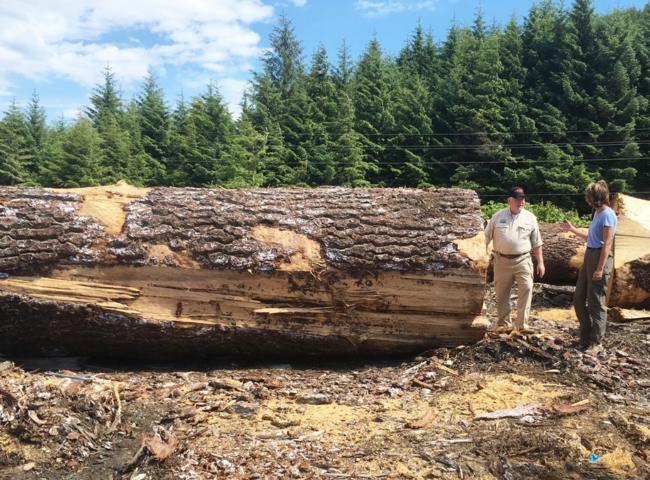
The U.S. Forest Service is moving ahead with one of the largest old growth timber sales Southeast Alaska has seen in years. The federal agency plans to make its decision official Saturday at a signing ceremony in Craig.
The Forest Service announced in 2016 it would largely phase out old growth timber sales in the Tongass over 15 years.
But this latest Prince of Wales Island LLA project projects harvesting as much as 225 million board feet of old growth lumber.
Alaska Forest Association Executive Director Owen Graham said young growth timber might employ seasonal lumberjacks but it’s the big trees that keep Southeast’s remaining mills open.
“The old growth portion will provide mill jobs and the young growth portion will almost exclusively end up getting shipped overseas,” Graham said. “But it’s providing jobs, those are good jobs.”
But he objected to some constraints imposed by the Forest Service. It won’t allow more than 100 acres of clear cut at a time.
Conservationists are alarmed by any new old growth logging.
“It’s going to be controversial any time the Forest Service plans a large old growth timber sale like this,” said Trout Unlimited in Alaska’s policy and legal director Austin Williams.
“If the Forest Service really wants to be responsive to people in Southeast Alaska, it’s going to have to figure out a way to stick to its plan to transition away from large scale old growth logging and get into more sustainable forest management.”
Trying to defining what “sustainable forest management” looks like goes to the heart of debate over the Tongass.
This project uses a new approach for the federal agency in Alaska. It specifies what could be authorized without pinpointing specifics areas.
That frustrates critics like Williams.
“It’s just really hard to tell exactly what this project might look like on the ground moving forward,” he said.
Even the timber industry agrees on that point.
“It’s disconcerting to people like me and others that were used to seeing projects that have a much higher level of detail,” Graham said. “But that doesn’t mean it is a bad project.”
The Alaska Department of Fish and Game raised concerns over losses to habitat. The state agency asked the Forest Service to minimize old growth clear-cuts to save deer. It also asked for buffers around known wolf dens.
Neither approach was included in the final plan.
“Removing the old growth forest tends to reduce habitat quality for deer in some cases quite dramatically,” said Tom Schumacher, regional supervisor for Fish and Game’s Division of Habitat in Southeast.
The Forest Service proposes to thin young forests to stimulate more undergrowth for deer to eat.
But he says when forests are thinned, it leaves a lot of debris on the ground.
“All that slash makes it very difficult for deer to access the area,” Schumacher said. “It’s a real obstacle course with all the trunks and limbs. So if you produce food there, we don’t know if it’s available to deer.”
Less deer means less food for wolves. That’s another concern for state wildlife biologists.
“Wolf conservation on Prince of Wales has been a controversial topic for decades and we’ve had two endangered species petitions to list wolves in that area,” Schumacher noted. “Both have been found unwarranted, but we suspect we’ll see another one at some point. So we want to be very careful with management of wolves in that area.”
The Forest Service’s landscape level analysis also describes up to 200 miles of in-stream restoration and as many as three new cabins and a dozen shelters plus hiking trails.
That’s welcomed by conservationists.
“The future of the Tongass is going to be in recreation, fishing, hunting, tourism, as well as I think we can have a robust forest products industry,” Williams said. “But it’s going to have to be based on young growth forest products.”
Which the logging industry argues does little for keeping the hundred or so remaining sawmill jobs in Southeast.
And so the Tongass debate continues. An official signing ceremony is slated for Saturday, March 16 in Craig.
